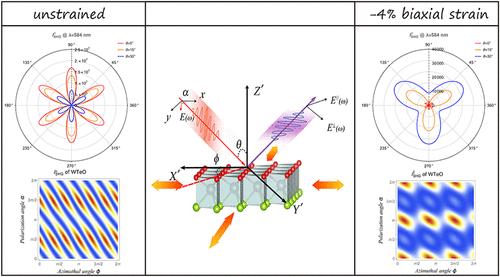实时应变检测器中WXO (X = S, Se, Te)在应变作用下的二次谐波演化:第一原理研究
IF 8.2
2区 材料科学
Q1 MATERIALS SCIENCE, MULTIDISCIPLINARY
引用次数: 0
摘要
二维非线性晶体为集成光电器件的小型化和多功能化带来了新的机遇。本文系统地研究了Janus材料WXO (X = S, Se, Te)的原子和电子结构、介电特性和二次谐波产生(SHG)。在分析一个大二阶非线性系数的物理来源的基础上,我们进一步研究了Janus WTeO的SHG模式强度和旋转对称性与应力-应变的关系。在双轴应变作用下,二阶非线性系数分别随压缩应变和拉伸应变发生蓝移和红移。同时平行强震强度显著降低2个数量级。此外,随着非线性强度的变化,SHG模式明显地从迷宫形状演变为气泡形状。这些结果揭示了应力条件下SHG的演化规律,为基于Janus WTeO的实时应变传感器的设计提供了理论依据。本文章由计算机程序翻译,如有差异,请以英文原文为准。

Evolution of Second Harmonic Generation of WXO (X = S, Se, Te) under Strain for Real-Time Strain Detectors: A First-Principles Investigation
Two-dimensional nonlinear crystals have brought new opportunities for the miniaturization and multifunctionality of integrated optoelectronic devices. Here, we systematically study the atom and electron structure, dielectric properties, and second harmonic generation (SHG) of Janus materials WXO (X = S, Se, Te). Based on the analysis of the physical origin of a large second-order nonlinear coefficient, we further investigate the dependence of the SHG pattern intensity and rotational symmetry for Janus WTeO on stress–strain. Under biaxial strain, the second-order nonlinear coefficients show blue and red shifts by the compression and tensile strain, respectively. Meanwhile the parallel SHG intensity significantly reduces by 2 orders of magnitude. Moreover, together with the change in the nonlinear intensity, the SHG pattern clearly evolves from a labyrinth-like shape to a bubble-like shape. These results reveal the SHG evolution under stress conditions and provide a theoretical basis for the design of real-time strain sensors based on Janus WTeO.
求助全文
通过发布文献求助,成功后即可免费获取论文全文。
去求助
来源期刊

ACS Applied Materials & Interfaces
工程技术-材料科学:综合
CiteScore
16.00
自引率
6.30%
发文量
4978
审稿时长
1.8 months
期刊介绍:
ACS Applied Materials & Interfaces is a leading interdisciplinary journal that brings together chemists, engineers, physicists, and biologists to explore the development and utilization of newly-discovered materials and interfacial processes for specific applications. Our journal has experienced remarkable growth since its establishment in 2009, both in terms of the number of articles published and the impact of the research showcased. We are proud to foster a truly global community, with the majority of published articles originating from outside the United States, reflecting the rapid growth of applied research worldwide.
 求助内容:
求助内容: 应助结果提醒方式:
应助结果提醒方式:


